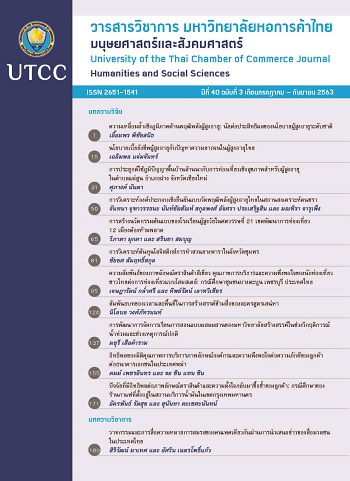Innovative School Prototype of the Elderly in the 21St Century in the 12 Hidden Gems
Main Article Content
Abstract
This research aimed to study 1) the level of learning promotion of the elderly and 2) the guidelines to create innovative school prototype of the elderly in the 21st century in the 12 hidden gems. The research tools were the questionnaire and interview. The questionnaires were taken from 400 elderly and the interviews of 36 people. The statistics used in the research were mean and standard deviation. The results from the in-depth interview were used for the content analysis, synthesis, and interpretation for the guidelines to create innovative school prototype of the elderly. The findings were: 1) the learning promotion of the elderly according to the level of significance were physical and mental health, social relationship, economic and income, and the recreation, respectively; and 2) the guidelines for innovative school prototype of the elderly in the 21st century were to support and develop the elderly to have better quality of life in both physical and mental aspects. Moreover, it also promotes occupational development and potential development of the elderly to have ability to share knowledge and experience to friends and people in community.
Article Details
ลิขสิทธิ์ของบทความ
ผลงานที่ได้รับการตีพิมพ์ถือเป็นลิขสิทธิ์ของมหาวิทยาลัยหอการค้าไทย ห้ามมิให้นำเนื้อหา ทัศนะ หรือข้อคิดเห็นใด ๆ ของผลงานไปทำซ้ำ ดัดแปลง หรือเผยแพร่ ไม่ว่าทั้งหมดหรือบางส่วนโดยไม่ได้รับอนุญาตเป็นลายลักษณ์อักษรจากมหาวิทยาลัยหอการค้าไทยก่อน
References
กรมการปกครอง. (2561). สถิติผู้สูงอายุของประเทศไทย 77 จังหวัด. สืบค้นเมื่อ 9 มกราคม 2562, จาก http://www.dop.go.th/download/knowledge/th1550973505-153_0.pdf.
กรมกิจการผู้สูงอายุ. (2559). คู่มือโรงเรียนผู้สูงอายุ. กรุงเทพฯ: ผู้แต่ง.
จุฑารัตน์ แสงทอง. (2556). ประสบการณ์ชีวิตและการเห็นคุณค่าในตนเองของผู้สูงอายุที่ปฏิบัติงานอาสาสมัคร ในโรงพยาบาลของรัฐ (วิทยานิพนธ์ปริญญามหาบัณฑิต ไม่ได้ตีพิมพ์). มหาวิทยาลัยธรรมศาสตร์, กรุงเทพฯ.
ชูชัย สมิทธิไกร. (2554). การฝึกอบรมบุคลากรในองค์กร (พิมพ์ครั้งที่ 7). กรุงเทพฯ: จุฬาลงกรณ์มหาวิทยาลัย.
พยัต วุฒิรงค์. (2557). การจัดการนวัตกรรม: ทรัพยากรองค์การแห่งการเรียนรู้และนวัตกรรม. กรุงเทพฯ: จุฬาลงกรณ์มหาวิยาลัย.
ระวี สัจจโสภณ. (2556). แนวคิดทางการศึกษาเพื่อการพัฒนาภาวะพฤฒิพลังในผู้สูงอายุ. วารสารวิทยาสารเกษตรศาสตร์ สาขาสังคมศาสตร์, 34(3), 471-490.
วรนาถ พรหมศวร. (2559). โรงเรียนผู้สูงอายุ มุมมองตามบริบทชุมชนท้องถิ่น สุรินทร์. สุรินทร์: วิทยาลัยพยาบาลบรมราชชนนี.
ศศิพัฒน์ ยอดเพชร. (2560). โครงการ การถอดบทเรียนตัวอย่างที่ดีของโรงเรียนและชมรมผู้สูงอายุที่มีกิจกรรมถ่ายทอดความรู้. กรุงเทพฯ: เจพริ้นท์.
สมศักดิ์ ศรีสันติสุข. (2550). สังคมวิทยาชนบท: แนวคิดทางทฤษฎีและแนวโน้มในสังคม. กรุงเทพฯ: เอ็กซ์เปอร์เน็ท.
สํานักงานคณะกรรมการพัฒนาการเศรษฐกิจและสังคมแห่งชาติ. (2559). แผนพัฒนาเศรษฐกิจและ สังคมแห่งชาติฉบับที่ 12 (พ.ศ. 2559-2564). กรุงเทพฯ: สํานักนายกรัฐมนตรี.
สำนักงานคณะกรรมการสุขภาพแห่งชาติ. (2552). พระราชบัญญัติสุขภาพแห่งชาติ พ.ศ. 2550. กรุงเทพฯ: โรงพิมพ์ เจ เอสการพิมพ์.
อาชัญญา รัตนอุบล, สารีพันธุ์ ศุภวรรณ, วีระเทพ ปทุมเจริญวัฒนา, มนัสวาสน์ โกวิทยา, วรรัตน์ ปทุมเจริญวัฒนา, ปาน กิมปี, ... ระวี สัจจโสภณ. (2555). การพัฒนาแนวทางการส่งเสริมการจัดการศึกษา/การเรียนรู้เพื่อการพัฒนาศักยภาพผู้สูงอายุ. วารสารครุศาสตร์, 40(1), 14-28.
อุบล วัฒนศักดิ์ภูบาล. (2553). การจัดสวัสดิการสังคมสำหรับผู้สูงอายุขององค์การบริหารส่วนตำบลบางเขา อำเภอหนองจิก จังหวัดปัตตานี. (วิทยานิพนธ์ปริญญามหาบัณฑิต ไม่ได้ตีพิมพ์). มหาวิทยาลัยขอนแก่น.
Drucker, P. F. (2002). The discipline in the innovation. Harvard Business Review, 80, 95-104.
Haggstrom, B. M. (Ed.). (2003). The role of libraries in lifelong learning: Final report of the IFLA project under the section for public libraries. Retrieved March 7, 2014, from http://www.ifla.org/publications/the-role-of-libraries-in-lifelong-learnin.
Kamble, G., & Sidhaye, N. (2010). Lifelong learning. Retrieved July 20, 2013, from http://www.articlesbase.com/education-articles/life-long-learning2904759.
Likert, R. A. (1932). Technique for the measurement of attitudes. Arch Psychological, 25(140), 1-55.
Marsick, V.J., & Watkins, K.E. (1994). The Learning Organization: An Integrative Vision for HRD. Human Resource Development Quarterly, 5(4), 353-359.
Nohria, N., & Gulati, R. (1996). Is slack good or bad for innovation?. Academy of Management Journal, 39(5), 1245-1264.
Nordstrom, N. M. (2011). Top 10 benefits of lifelong learning. Retrieved July 20, 2013, from www.selfgrowth.com/articles Top 10 Benefits Of Lifelong Learning.
Schilling, M. A. (2008). Strategic management of technological innovation (2nd. ed.). New York, NY: McGraw-Hill Education.
United Nations Educational, Scientific and Cultural Organization. (1981). Quality of life: An orientation to population to population. Bangkok: Author.
Utterback, J. M. (2004). The dynamics of Innovation. Edu Cause Review, 39(1), 42.
Yamane, T. (1976). Statistics: An Introductory Analysis. New York, NY: Harper & Row.
Zhan, L. (1992). Quality of life: Conceptual and measurement issues. Journal of Advance Nursing, 17(7), 759-800.


